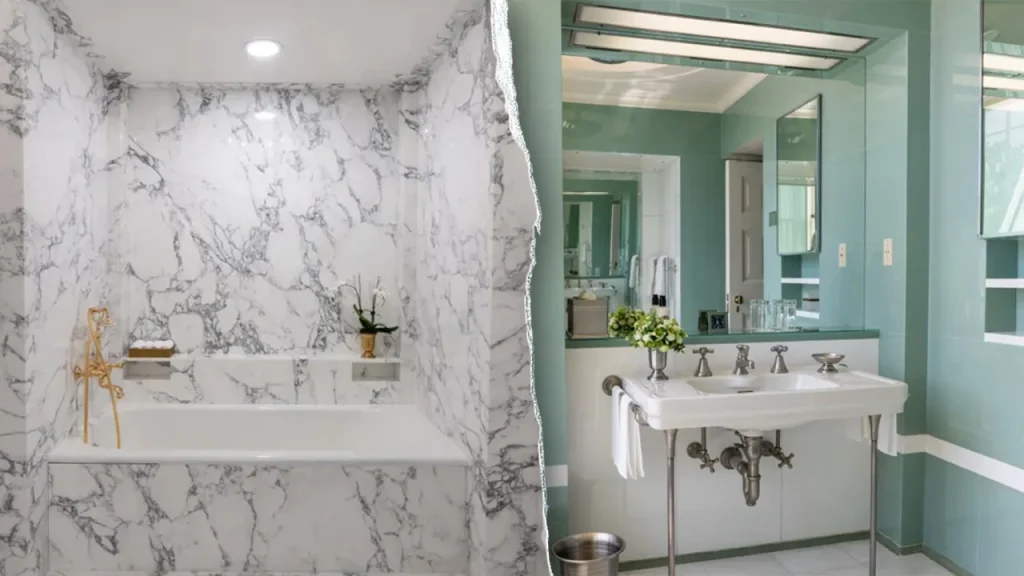Trump Completes Lincoln Bedroom Bathroom Renovation at the White House
President Donald Trump has unveiled the newly renovated Lincoln Bedroom bathroom in the White House, sharing images of the transformed space on his Truth Social platform. The bathroom, which had not been updated since the 1940s, has undergone a complete makeover that Trump believes better honors the historical significance of the space associated with America’s 16th president. “I renovated the Lincoln Bathroom in the White House. It was renovated in the 1940s in an art deco green tile style, which was totally inappropriate for the Lincoln Era,” Trump explained in his social media post. The previous green tile design has been replaced with polished black-and-white statuary marble that Trump feels is more authentic to Lincoln’s time period, suggesting it might even resemble “the marble that was originally there.”
The renovation showcases the administration’s attention to historical detail and preservation of White House heritage. The Lincoln Bedroom itself has been known by that name since 1945, when President Harry S. Truman had it furnished with pieces from Lincoln’s era. Located in the southeast corner of the White House’s second floor, the room and its adjoining spaces carry significant historical weight. The newly renovated bathroom features elegant gold fixtures complementing the polished marble walls, creating a dignified atmosphere that Trump believes better reflects the gravitas of the Lincoln legacy. Through multiple posts, the President shared photographs highlighting the craftsmanship of the renovation and expressing pride in restoring the space to what he considers a more period-appropriate aesthetic.
This bathroom renovation is part of a larger series of White House improvement projects undertaken during Trump’s administration. Most notably, construction crews have recently begun work on a much more ambitious project: tearing down part of the East Wing to make way for a new White House ballroom. Unlike many government-funded renovations, this substantial ballroom project—estimated to cost approximately $250 million—will be financed through a combination of the President’s personal funds and private donations. The ballroom initiative addresses what the administration views as a practical limitation of the current White House configuration, which lacks appropriate indoor space for major diplomatic functions.
White House Press Secretary Karoline Leavitt explained the reasoning behind the ballroom project during a July briefing: “The White House is currently unable to host major functions honoring world leaders in other countries without having to install a large and unsightly tent approximately 100 yards away from the main building’s entrance.” The current practice of erecting temporary structures for large gatherings has long been viewed as an inelegant solution for a building that serves as both the presidential residence and a symbol of American democracy. The new ballroom would allow the White House to host significant diplomatic and ceremonial events in a space designed specifically for such purposes, eliminating the need for temporary accommodations.
Presidential renovations to the White House have a long and sometimes controversial history, with each administration leaving its mark on the historic building. While some changes are purely functional or reflect maintenance necessities, others—like Trump’s ballroom project—represent more substantial alterations to the iconic structure. The White House Historical Association, which maintains records of such changes, documents how the building has evolved through various administrations. The Lincoln Bedroom itself represents this evolution—originally serving as an office and cabinet room during Lincoln’s presidency before being transformed into its current configuration nearly a century later during Truman’s administration.
These White House renovation projects highlight the delicate balance between preserving historical integrity and meeting the modern needs of a functioning presidential residence and workplace. While the Lincoln Bathroom renovation represents a relatively modest update aimed at historical authenticity, the ballroom project signals a more dramatic evolution of the White House complex. Both projects reflect Trump’s personal interest in architecture and design, as well as his desire to leave a lasting mark on the presidential residence. As with previous administrations’ renovations, these changes will become part of the ongoing historical record of how each president has shaped and reshaped the physical space of America’s most famous address, blending personal taste with practical considerations while attempting to honor the building’s rich heritage.


